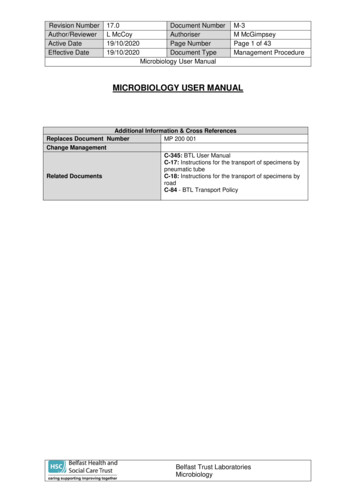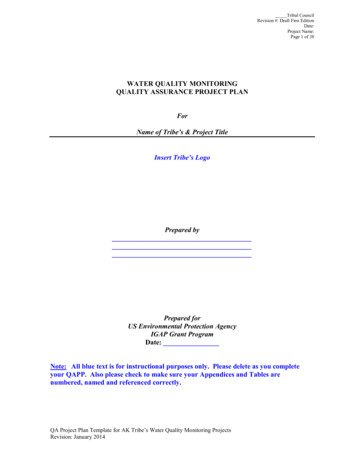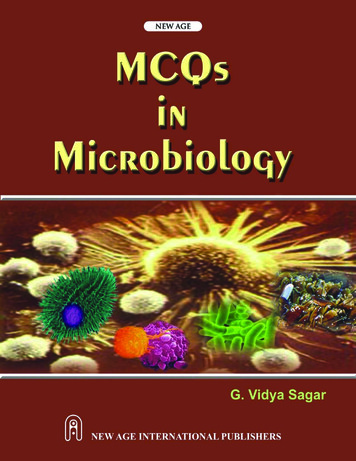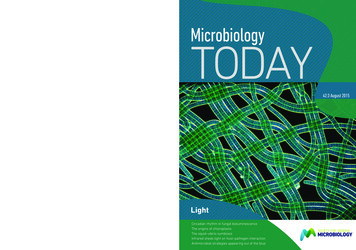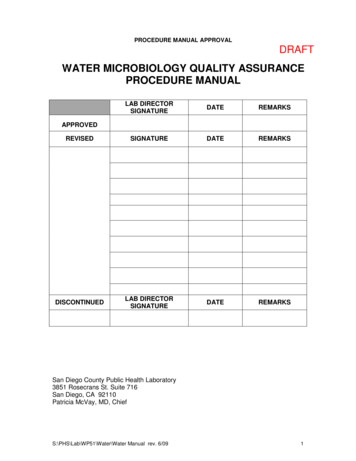
Transcription
PROCEDURE MANUAL APPROVALDRAFTWATER MICROBIOLOGY QUALITY ASSURANCEPROCEDURE MANUALLAB MARKSDISCONTINUEDLAB DIRECTORSIGNATUREDATEREMARKSAPPROVEDSan Diego County Public Health Laboratory3851 Rosecrans St. Suite 716San Diego, CA 92110Patricia McVay, MD, ChiefS:\PHS\Lab\WP51\Water\Water Manual rev. 6/091
WATER MICROBIOLOGYQUALITY ASSURANCEMANUALS:\PHS\Lab\WP51\Water\Water Manual rev. 6/092
TABLE OF CONTENTSORGANIZATION AND PERSONNEL RESPONSIBILITIES. 5Organization . 5CLIA-Regulated Personnel . 5Testing Personnel: Public Health Microbiologists . 5General Supervisor: Senior Public Health Microbiologist . 6Technical Supervisor: Supervising Public Health Microbiologist . 7Laboratory Director: Chief, Public Health Laboratory . 8QA OBJECTIVES FOR MEASUREMENT DATA . 11Quality Control/Quality Assurance Procedures. 11QC Procedure for Purified Laboratory Water . 11Routine tests performed on laboratory reagent water. 12Sterility Check Procedure for Water Specimen Collection Containers . 13All containers used for bacteriological sampling:. 13Sterility testing of buffered dilution water:. 13Tryptic soy broth QC:. 1390 mL DI water bottles:. 13IDEXX: . 13SAMPLING PROCEDURES . 14Water Sample Collection Procedure. 14GENERAL INFORMATION . 14COLLECTION AND LABELING . 15PACKAGING AND DELIVERY. 16SAMPLE CUSTODY, HOLDING AND DISPOSAL . 17General Instructions for Handling of Water Samples for Microbiological Analysis. 17CALIBRATION PROCEDURES AND FREQUENCY. 19ROUTINE TESTS FOR PURIFIED LABORATORY WATER. 19ANNUAL TESTS FOR PURIFIED LABORATORY WATER . 21TOTAL CHLORINE - HACH TEST KIT. 22TEST FOR INHIBITORY RESIDUES ON GLASSWARE AND PLASTICWARE . 29ANALYTICAL PROCEDURES . 31MOST PROBABLE NUMBER (MPN) METHOD FOR TOTAL COLIFORM DETERMINATION . 31General Instructions . 31Sea Water Samples . 32Sewage Samples . 32MOST PROBABLE NUMBER METHOD FOR FECAL COLIFORM DETERMINATION . 34MOST PROBABLE NUMBER METHOD FOR MUD, SEDIMENTS AND SLUDGES. 35COLILERT PRESENCE/ABSENCE METHOD FOR DRINKING WATER . 36VERIFICATION OF TOTAL COLIFORMS AND Escherichia coli IN COLILERT CULTURES . 38HETEROTROPHIC PLATE COUNT. 39TEST METHOD FOR ENTEROCOCCI IN WATER BY MEMBRANE FILTRATION PROCEDURE40ENTEROLERT ENTEROCOCCUS MPN PROCEDURE . 44COLILERT–18 QUANTI-TRAY NUMERATION PROCEDURE FOR SEAWATERS . 48ACQUISITION, DATA REDUCTION, VALIDATION AND REPORTING . 53Determining the MPN/100 mL for MTF method. 53INTERNAL QUALITY CONTROL CHECKS AND CORRECTIVE ACTIONS. 60MEDIA QUALITY CONTROL/ASSURANCE PROCEDURE OUTLINE . 60THERMOMETER Q.C. AND CALIBRATION. 65MEDIA PREPARATION RECORDS. 66KILIT VIAL OR DUO SPORE/TEMPERATURE CHECK. 68AUTOCLAVE AND STERILIZER CLEANING AND TEMPERATURE VERIFICATION. 69DUO-SPORE: AUTOCLAVE QUALITY CONTROL . 70DRY HEAT STERILIZER USE AND QC PROCEDURE . 71DAILY pH CHECK OF GLASSWARE. 72S:\PHS\Lab\WP51\Water\Water Manual rev. 6/093
DETERMINATION OF CONDUCTIVITY OF PURIFIED WATER FOR MEDIA PREPARATION . 73PERFORMANCE AND SYSTEMS AUDITS. 75QC/QA FORMS FOR WATER BACTERIOLOGY . 75PREVENTIVE MAINTENANCE . 76ASSESSMENT OF PRECISION AND ACCURACY . 77CORRECTIVE ACTION . 78QUALITY ASSURANCE REPORTS. 79QUALITY ASSURANCE REPORT FORMS . 79APPENDIX A. 81Schedule of duties and Computer locations of forms: . 81S:\PHS\Lab\WP51\Water\Water Manual rev. 6/094
ORGANIZATION AND PERSONNEL RESPONSIBILITIESOrganization1. In general, trained laboratory assistants and public health microbiologists perform allwater testing procedures.2. Results are checked before reports are issued by the senior or Supervising Public HealthMicrobiologist. For drinking water analyses performed by laboratory assistants, the actualresults will be visibly verified by a microbiologist.3. Reports are then given to the Chief of the Public Health Laboratory for final review beforemailing or faxing by clerical staff. If the Chief is not available, this step is omitted.CLIA-Regulated PersonnelTesting Personnel: Public Health Microbiologists1. Review the procedure and quality assurance manuals for the duties assigned (a) within 2weeks after a change in assignments and (b) every 12 months if the assignment is 6months.2. Review the laboratory safety manual (a) within 2 weeks after beginning employment and(b) every 12 months thereafter.3. Under the direction of the Supervising or Senior Public Health Microbiologist, becomeproficient in performing all microbiology and serology tests which you are assigned toperform.4. Perform any microbiological or serological test, as assigned, following training andorientation under the supervision of the Supervising Public Health Microbiologist.5. Process specimens, perform tests, and prepare and initial reports and forward to Senioror Supervising Public Health Microbiologist for review.6. In each section to which you are assigned, follow the written procedures for specimencollection, criteria for specimen acceptance or rejection, testing, quality control andassurance, and reporting as documented in procedure manuals and the safety manual.7. Document all quality control activities, instrument and procedure calibrations, andmaintenance performed.8. Follow established policies and procedures whenever test systems are not within theestablished acceptable level of performance. Record remedial action taken when testsare out of control.9. Handle and test proficiency testing (PT) samples in the same manner as routine patientsamples and document this.S:\PHS\Lab\WP51\Water\Water Manual rev. 6/095
10. Use written procedures and quality control to identify problems that may adversely affectperformance or reporting of test results. Notify Senior or Supervising Public HealthMicrobiologist immediately when problems are identified.11. If licensed as a Clinical Laboratory Technologist, carry out responsibilities of that jobclass, as requested.12. Complete the weekend coverage checklist and hand in to your supervisor on Mondaymorning before the weekend you are scheduled to work.General Supervisor: Senior Public Health Microbiologist1. Perform onsite general supervision and oversight of laboratory operations and personnelperforming testing in one unit of the laboratory, as assigned. Be present in the laboratorywhen testing is being performed. Assignments can be in any one of the following units:Mycobacteriology, General Bacteriology, Virus Serology, and Virus Isolation.2. Review the procedure and quality assurance manuals for the particular unit to which youare assigned (a) within 2 months after a change in assignments and (b) every 12 monthsif the assignment is 6 months. Prepare and revise manuals as directed by yourtechnical supervisor.3. Review the laboratory safety manual (a) within 2 weeks after beginning employment and(b) every 12 months thereafter.4. Under the direction of the Supervising Public Health Microbiologist, become proficient inperforming all microbiology and serology tests performed in the unit you are supervising.5. Perform any microbiological or serological test, as needed to assist other staff incompleting daily workload, following training and orientation under the supervision of theSupervising Public Health Microbiologist.6. In each unit which you are assigned to supervise, monitor test analyses and specimenexaminations to ensure that acceptable levels of analytic performance are maintained, asdefined in the procedure and quality assurance manuals. This includes making sure thattesting personnel do the following:a. Follow the written procedures for specimen collection, criteria for specimenacceptance or rejection, testing, quality control, and reporting as documented inprocedure manuals and the safety manual.b. Document all quality control activities, instrument and procedure calibrations, andmaintenance performed.c. Forward reports to Senior or Supervising Public Health Microbiologist for reviewprior to sending out.d. Follow established policies and procedures whenever test systems are not withinthe established acceptable level of performance. Record remedial action takenwhen tests are out of control.S:\PHS\Lab\WP51\Water\Water Manual rev. 6/096
e. Test results are not reported until any necessary corrective actions have beentaken and the test system is properly functioning.f. Handle and test proficiency testing (PT) samples in the same manner as routinepatient samples and document this.7. Provide orientation and training to new testing personnel and determine when they arecapable of performing accurate and reliable testing.8. Annually evaluate performance of all Public Health Microbiologists (testing personnel)assigned to the unit you are supervising. Assist the Technical Supervisor in evaluatingcompetency of testing personnel.9. If licensed as a Clinical Laboratory Technologist, carry out responsibilities of that job classor Senior Clinical Laboratory Technologist, as assigned.10. Complete the weekend coverage checklist (form Lab 57) and hand in to your supervisoron Monday morning before the weekend you are scheduled to work.Technical Supervisor: Supervising Public Health Microbiologist1. Provide onsite technical and scientific oversight of the laboratory during normal operatinghours, Monday through Friday.2. When the General Supervisor is not available, monitor work performed by testingpersonnel, checking quality control, and accuracy of test reports before sending out.3. Review procedure and quality assurance manuals in the areas assigned to supervisewithin 2 months after hiring and annually thereafter. Prepare and revise manuals oroversee the preparation and revision of manuals by general supervisors as needed.Submit new and revised procedures to Chief, Public Health Laboratory for review beforeimplementation.4. Make sure that a copy of each procedure is maintained with dates of initial use anddiscontinuance. Retain copies of discontinued procedures for 2 years.5. Provide onsite or telephone consultation for testing personnel, physicians, nurses, andpublic health workers as needed.6. Select and implement new or improved test methodologies as appropriate for their clinicaluse.7. Verify test procedures performed and establish test performance characteristics including(where applicable) accuracy and precision of each test and test system.8. Enroll and participate in an HHS approved proficiency testing program commensuratewith services offered.S:\PHS\Lab\WP51\Water\Water Manual rev. 6/097
9. Establish a quality control program and prepare quality assurance manuals appropriatefor the testing performed and establish standards for acceptable levels of analyticalperformance. Ensure these standards are maintained through the entire specimenreceiving, testing and reporting process.10. Resolve technical problems. Ensure remedial action is taken and documented whenevertest systems deviate from established performance standards.11. Ensure patient test results are not reported until necessary corrective actions have beentaken and the test system is functioning properly.12. Identify training needs and ensure that Testing Personnel and General Supervisors underyour supervision receive regularly scheduled in-service training and educationappropriate for the type and complexity of testing services they perform.13. Evaluate competency of Clinical Laboratory Technologists and Public HealthMicrobiologists (Testing Personnel) under your supervision, assuring that they maintaintheir competency to perform and report tests accurately and efficiently. This shall bedone on an ongoing basis using all of the following methods:a. Direct observations of patient test performance including patient preparation (ifapplicable), specimen handling, processing, and testing.b. Monitoring the recording and reporting of test results.c. Review of intermediate test results or worksheets, quality control records,proficiency testing results, and preventive maintenance records.d. Direct observation of performance of instrument maintenance and functionchecks.e. Assessment of test performance through testing previously analyzed specimens,internal blind testing samples, or external proficiency testing samples.f. Assessment of problem solving skills.14. Performance evaluation of testing personnel using the above methods must becompleted at least semiannually during the first year the individual tests specimens.Thereafter, evaluation must be conducted at least annually, unless methodology orinstrumentation changes, in which case evaluation must be done within 6 monthsfollowing the changes.Laboratory Director: Chief, Public Health Laboratory1. Assume responsibility for overall laboratory operation and administration, including hiringpersonnel competent to perform test procedures, record and report test results promptly,and assuring compliance with applicable regulations.2. Assume the responsibilities and duties of Technical or General Supervisor or TestingPersonnel when needed due to staff vacancies or absences.S:\PHS\Lab\WP51\Water\Water Manual rev. 6/098
3. Be accessible to the laboratory to provide onsite, telephone, or electronic consultation asneeded.4. Must direct no more than 5 laboratories.5. Ensure that methods used to perform lab tests provide quality lab services for all aspectsof test performance including preanalytic, analytic, and post-analytic phases of testing.6. Ensure that physical and environmental lab conditions are appropriate for tests beingperformed and that employees are protected from physical, chemical, and biologicalhazards.7. Ensure that test methods used provide the quality of results required for patient care.8. Ensure that adequate verification procedures are used to determine accuracy, precision,and other pertinent performance characteristics of the method.9. Ensure that Testing Personnel are performing tests as required for accurate and reliableresults.10. Ensure that the lab is enrolled in a HHS-approved proficiency testing program for thetesting being performed.11. Ensure that proficiency testing samples are handled as follows:a. Samples are tested with the regular workload using routine methods by personnelwho routinely perform the tests.b. Samples are tested the same number of times as routine specimens.c. There is no communication with other labs, sharing of results, or referral ofsamples for proficiency testing to other labs.d. Pre-analytical, analytical, and reporting steps are documented. Maintain copies ofrecords for at least 2 years.e. Results are returned to the proficiency testing service within the specified timelimits.f. Appropriate staff review proficiency testing report received to evaluate the lab'sperformance and identify and correct any problems.g. When corrective action is necessary, appropriate staff review all steps in analysis,repeat testing if applicable, determine source of problem, and implementcorrected procedure.12. Ensure that quality control and assurance programs are established and maintained toassure high quality of services and identify failures in quality as they occur.13. Ensure establishment and maintenance of acceptable levels of analytical performance foreach test system.14. Ensure that necessary remedial actions are taken and documented when performancestandards are not met and that patient results are only reported when test systems arefunctioning properly.S:\PHS\Lab\WP51\Water\Water Manual rev. 6/099
15. Ensure that reports of test results include information required for interpretation.16. Ensure that consultation regarding quality of test results and their interpretation in relationto patient conditions is available to those submitting specimens for testing.17. Employ sufficient staff with appropriate education, training, and experience to providenecessary consultation and supervision of the performance and reporting of test results,as defined in personnel responsibilities.18. Ensure that prior to testing specimens, personnel have necessary education, training,and experience and have demonstrated they can perform and report the tests accurately.19. Ensure that policies and procedures are developed to monitor all phases of collection,testing, and reporting by testing personnel make sure that results are reported promptlyand accurately. Identify needs for remedial training and continuing education to improveskills.20. Ensure that approved procedure manuals are available to Testing Personnel coveringeach aspect of the testing process.21. Specify responsibilities and duties of Clinical Consultant, Technical Supervisors, GeneralSupervisors, and Testing Personnel engaged in any aspect of testing. Specify whichprocedures each individual is authorized to perform.22. Ensure that microbiology and serology lab reports are checked by a Senior orSupervising Public Health Microbiologist and that clinical chemistry, hematology, andurinalysis lab reports are checked by a Senior or Supervising Clinical Lab Technologistprior to sending out reports.23. Approve all new procedures or modifications of procedures (except typographical errors)by signing name and date at the time they are implemented. Document discontinuationof procedures by signing name and date at the time they are discontinued.24. Review and amend if necessary the Quality Assurance Manual and Program for WaterMicrobiology annually or whenever there are changes in methods or lab equipmentemployed, in the laboratory structure or physical arrangements, or changes in thelaboratory organization.S:\PHS\Lab\WP51\Water\Water Manual rev. 6/0910
QA OBJECTIVES FOR MEASUREMENT DATAQuality Control/Quality Assurance ProceduresMedia and reagents must be checked and found satisfactory prior to routine use. For media,check for sterility and also determine that it supports the growth of desired organisms andgives correct indicator reactions. Specific information on QC procedures for the varioustypes of media is given in the various procedures in which they are used in this manual.Information on shelf life is given throughout the procedures also. If shelf life is not listed,assume the medium is to be prepared fresh each time it is needed.Generally all QC results are to be recorded in the QC log book of Media, Reagent and StainPreparation Record Sheets. pH meter checks with standard buffers are recorded onreverse of Media preparation log sheets.QC Procedure for Purified Laboratory WaterSpecific procedures for the tests listed below are found in the following sections of thismanual.FrequencyLimitsTestConductivity ofdaily 1.0 umhos/cm (State limit; EPA limit 2.0)purified water(NOTE: Resistivity of deionized water is checked daily. Resistivity must be greater than 0.5megohms.)SPCTotal ChlorineMonthlyDaily 500 CFU/mL 0.1 mg/LpHDaily5.5-7.5Heavy MetalsAnnually 1.0 mg/LBacteriologic qualityof laboratorywater testAnnuallyratio of 0.8-1.2or when conditionschangeThe Glassware InhibitoryResidues testAnnually orwhen conditions changeS:\PHS\Lab\WP51\Water\Water Manual rev. 6/0911
Routine tests performed on laboratory reagent water SPC (standard plate count) is performed monthly with both 0.1 and 1.0 mL of sample asdescribed in section 8. Acceptable results are 1,000 cfu/mL. When unacceptablecounts occur the microbiologists are to define the problem. Resistivity (reciprocal of conductivity) is checked and recorded daily on the form in theMedia Section of the laboratory using the in-line resistivity meter. Acceptable results are 0.5 megohm. Conductivity is also determined using a hand-held meter and the resultsare recorded on the same form used for recording pH meter and analytical balancecalibration. pH is checked daily after calibrating the pH meter with pH 7.0 buffer. The meter is alsocalibrated each Monday with both pH 4.0 and 10.0 buffers. Immerse the pH electrodeapproximately one inch deep in the container of water, avoiding the sides and bottom.Acceptable results are 5.5-7.5. Total chlorine is checked daily using the HACH reagents and a meter. Acceptable resultsare 0.1 mg/L chlorine. Hardness of water is checked daily using the HACH Hardness Test Kit model 5B.Instructions are listed on the kit and under Calibration Procedures in this manual.All QC is recorded in the Water System QC Notebook kept in the Water Room. If any QCparameters are out of range they should be rechecked. If still out of range, the SupervisingPH Microbiologist should be notified. The results are to be checked by the Senior LaboratoryAssistant and Supervisor.Reference:1. Standard Methods for Examination of Water and Wastewater, 18th Edition, APHA.S:\PHS\Lab\WP51\Water\Water Manual rev. 6/0912
Sterility Check Procedure for Water Specimen Collection ContainersAll containers used for bacteriological sampling:One sample cup or vial from each new lot is checked for sterility by adding 100 mL oftryptic soy broth (TSB) and incubating at 35oC for 48 hours. If growth is observed,containers are unsuitable and should not be used. The accuracy of the 100 mL mark onthe Colilert containers is verified at the same time by checking the level of TSB. Recordresults on the water media QC sheet located in the Water Section QC notebook. Notifythe Senior or Supervising Microbiologist if results are unacceptable.Sterility testing of buffered dilution water:In addition to recording the pH of each batch of dilution water, each batch needs to betested for sterility. This is done by adding 20 mL of dilution buffer to 100 ml TSB andincubating for 48 hours at 35ºC. If growth is present the batch should be rejected and resterilized.Tryptic soy broth QC:Tryptic soy broth is prepared by the media section and placed into a 100 mL bottle andkept in the media refrigerator. Additional TSB is dispensed into four 16x125mL tubes.The tubes are inoculated with the following organisms: E. coli, E. aerogenes, and P.aeruginosa. One tube is uninoculated as a sterility check. The tubes are incubated for 48hours at 35ºC. A positive reading is growth or turbidity. A negative reading is no growthor clear.90 mL DI water bottles:Check for sterility by adding 10-20 mL of the DI water from a bottle to 100 mL of trypticsoy broth. Incubate or 48 hours at 35ºC. A positive reading is growth or turbidity. Anegative reading is no growth or clear.IDEXX:Sterility check for sample containers from IDEXX are checked per each lot and recordedon the Water Media QC Form. At least one bottle from each lot of sample containers istested for sterility by adding 25 mL of a sterile Tryptic Soy Broth (TSB) to a bottle,incubating it at 35 0.5ºC for 24 hours and checking for growth.All forms are reviewed monthly by the Supervising Microbiologist. Any corrective actionsperformed because of QC failures or values "out-of-range" should be recorded on theseforms and the Senior or Supervising microbiologist informed.S:\PHS\Lab\WP51\Water\Water Manual rev. 6/0913
SAMPLING PROCEDURESWater Sample Collection ProcedureGENERAL INFORMATIONDrinking water samples may be submitted to and received by the Public Health Laboratoryfor testing on Monday through Wednesday. Other water samples should be submittedMonday and Tuesday. When samples need to be tested on other days, please consult withthe Laboratory before submitting samples. Normal lab hours are Monday through Fridayfrom 8:00 AM to 5:00 PM.When samples other than potable water or sea water are submitted consult with the lab inadvance to specify what upper endpoints are anticipated and needed. Routine sea watertesting has an upper endpoint of 16,000 organisms/100 mL while potable water is testedby the Presence/Absence method and no MPN is given.Two types of containers are provided for collecting water samples. Choose the correct typefor collecting the sample:1. Rigid CLEAR Plastic screw-cap bottles with 100 mL mark for potable water samplesonly. These bottles are sterile and contain sodium thiosulfate powder which is sufficientto dechlorinate 125 mL of water containing 10 mg/liter (or 10 PPM) of chlorine. Eachbottle is pre-numbered on the lid. Bottles MUST contain at least 100 mL or thespecimen will be unsatisfactory for testing.2. Rigid, sterile, OPAQUE plastic screw cap bottles for samples such as salt water,streams, lakes, sewage, seepage, and other non-potable waters. These bottles contain30 mg of sodium thiosulfate which is sufficient to dechlorinate 125 mL of watercontaining 45 mg/liter (or 45 PPM) of chlorine. Each bottle is pre-numbered with anumber on the side.Equipment and supplies needed for water sample collection:1.2.3.4.5.6.Sample collection containers (see above for appropriate type)Water-Bacteriology lab forms (DHS Lab 10)Pen with waterproof inkCardboard or metal screw cap mailing containers for potable samples.Ice chest with ice pack(s)Rubber bandsS:\PHS\Lab\WP51\Water\Water Manual rev. 6/0914
COLLECTION AND LABELING1. PROCEDURE FOR POTABLE WATER COLLECTION:a. Allow water to run from tap or pump from well at least two minutes before sampling.Do not collect samples from leaking faucets, swing faucets or faucets with aerators orscreens. Do not rinse or empty the chlorine neutralizing thiosulfate powder out of thecontainer.b. While waiting for the water to run for two minutes:Completely fill out Water Bacteriology form with waterproof pen. Be sure to writethe bottle number in the space provided on the form.Include the following information: Date of collection Time of collection Sample identification. Client name(s) Type of sampl
S:\PHS\Lab\WP51\Water\Water Manual rev. 6/09 1 PROCEDURE MANUAL APPROVAL DRAFT WATER MICROBIOLOGY QUALITY ASSURANCE PROCEDURE MANUAL San Diego County Public Health Laboratory 3851 Rosecrans St. Suite 716 San Diego, CA 92110 Patricia McVay, MD, Chief LAB





